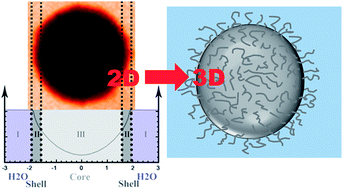Quantitative X-ray microscopic analysis of individual thermoresponsive microgel particles in aqueous solution†
Abstract
High resolution scanning soft X-ray transmission microscopy (STXM) has been employed to investigate individual thermoresponsive microgel particles in aqueous environments. STXM generates 2-dimensional projections with spatial resolutions in the regime of a few 10 s of nm. In the present study we are able to regain a 3D representation of the investigated specimen and observe the deswelling of the microgel particles upon heating, thus offering insight into the thermoresponsive behaviour of individual differently sized particles. We employ a 2-shell model that is able to derive the radial concentration profile of individual microgels particles and thus serves as a complementary method to scattering experiments that average over all particles. Furthermore, we are able to detect the different deswelling behaviour of the particle interior and its interface to the water environment.



 Please wait while we load your content...
Please wait while we load your content...